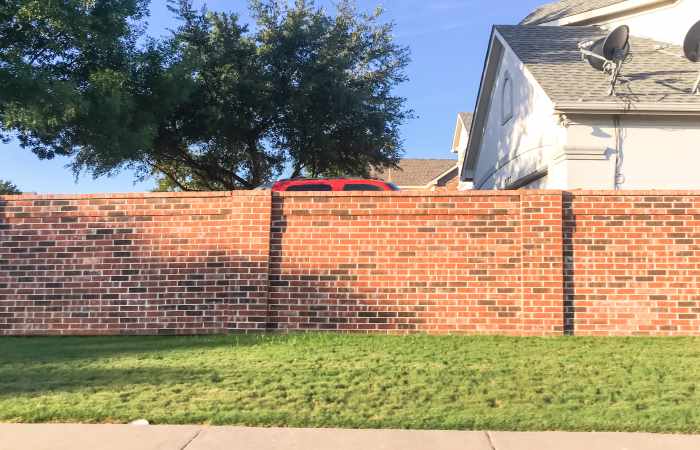Many people dream of transforming their backyard into an oasis in which they can get away from the sights, sounds, and stress of the outside world.
Yet for most of us, the reality is that our roadside homes and adjacent backyards are constantly assaulted by the noise of speeding cars, beeping trucks, wailing ambulances, and all the other cacophony of passing traffic.

Thankfully, there are some things you can do to silence the pandemonium.
While it’s impossible to block out all the noise coming into your yard fully, the following tips will allow you to kick back and enjoy your verdant haven.
The Principles of Sound Reduction
There are two main ways in which sound can be cut back. Understanding these techniques will help you plan out the layout of your yard or garden and decide which one will work best in your space.
Sound Deflection
This technique works by reflecting the sound waves away from your yard through the use of a physical barrier, such as a plexiglass or brick wall.
The effectiveness of sound deflection depends on the density and height of the barrier material you choose to use.
Putting up a large, dense wall between your backyard and the source of the noise will make it so that any approaching sound waves will bounce off the barrier, greatly reducing the level of noise that makes through into your yard.
If the wall isn’t high enough, though, a significant amount of sound waves will be able to make it over the barrier and into your yard to disturb your peace.
Likewise, if the material is too thin, it won’t effectively reflect enough sound waves, and noise will get through.
Sound deflection is usually the most effective method of noise reduction. However, it is usually the most expensive to put in place properly.
Sound Attenuation
An easier technique for reducing noise pollution making its way into your yard is to attenuate or reduce, the amount of sound coming through.
While it isn’t as effective as sound deflection, it can still significantly reduce the racket disturbing your peaceful gardening time at a fraction of the price.
Like sound deflection, sound attenuation works by putting up blockades between your yard and the source of the noise.
Instead of reflecting the sound waves away, though, a sound attenuation barrier will absorb their energy and dampen their sound.
The barrier material that you use may have either sound deflecting or attenuating properties, or possibly even both. You’ll have to decide which kind of barrier is the best fit for your yard.
Things to Consider When Choosing a Barrier
There are a few important factors to keep in mind when deciding on what kind of barrier to install.
While there are many different options, it’s not just about which barrier looks best with your garden décor if you want effective noise reduction.
Barrier Height
A tall barrier is more likely to deflect or attenuate the majority of noises entering your yard, as most of them will be coming from ground level.
This is why it’s recommended that your barrier be at least 2 meters tall, if not more.
This way, even if sounds do make it over your barrier, most of the noise will travel right over your head.
Barrier Density
The denser your barrier, the fewer sound waves will be able to travel through it. Flexible barriers, such as thin wooden fences, will easily conduct sound right through them with minimal attenuation.
Whenever possible, choose thick, dense barriers such as brick or stone walls for maximum sound reduction.
Barrier Coverage
Your barrier must be completely solid if you want it to block out sound effectively.
If your barrier has cracks or spaces between panels, sound waves will easily come in through those spots. Likewise, your barrier should go all the way down to the ground.
A large gap in the bottom will allow a large amount of sound to sneak in underneath your barrier.
It’s thought that if you can see the source of the sound, then you’ll definitely be able to hear it too.
Barrier Placement
Finally, where you place your barrier is very important. Place your barrier as close to the source of the noise as possible, as this will minimize the amount and intensity of sound waves entering your space.
Types of Barriers
Brick Walls
Brick walls are one of the best options when it comes to sound reducing barriers.
They can both deflect and attenuate noise, reducing sound by more than 50%. They can also be built to any height and thickness you need them to be.
Building a brick wall can be expensive, however, as well as subject to local building regulations and height requirements.
Acoustic Fencing
Acoustic, or noise-reducing, fencing is insulated with sound-reducing materials such as acoustic wool or acoustic blocks, which both deflect and attenuate sound waves.
They can be an easy and less expensive solution than erecting a brick wall. However, they still cost more than metal or wood fencing.
Vegetation Barriers
Another great option is to implement noise reduction landscaping techniques that incorporate trees, shrubbery, and trees as sound barriers.
Using landscaping for privacy and noise reduction offers an aesthetic element to your garden as well, and can be very effective at reducing sound pollution.
A thick barrier of shrubs and hedges provide significant sound attenuation as the vegetation absorbs sound waves and disperses them as heat.
Trees planted close together can also provide effective coverage, as their trunks deflect sound while their branches and leaves attenuate and dissipate it.
They even make their own sounds as the wind blows through them, helping to drown out unwanted noises further.
Living barriers can last for years, if not decades, when well cared for. However, they can take some time to become established enough to provide the desired noise reduction effects.
Wooden Fences
Wooden fences are easy and less expensive to install, and depending on the thickness can provide some level of noise reduction.
However, they’re not as effective as other methods and are prone to rot.
Metallic Panels
Metallic panel barriers are the least effective, as the panels can actually vibrate and magnify sound waves.
They are easy and inexpensive to install, though, and can provide a very minimal level of sound deflection.
Water Features
Although not technically a barrier, running water features such as fountains, streams, or a pond with a waterfall can create their own pleasing sound that can help to drown out unpleasant noise.
In Summary
There are plenty of options for reducing noise pollution in your backyard, so you’ll have to carefully decide which one will work best with your garden layout and overall budget.
While tall and dense structures make the best barriers, there are less expensive and intrusive options you can consider as well to help restore the serenity of your backyard.










